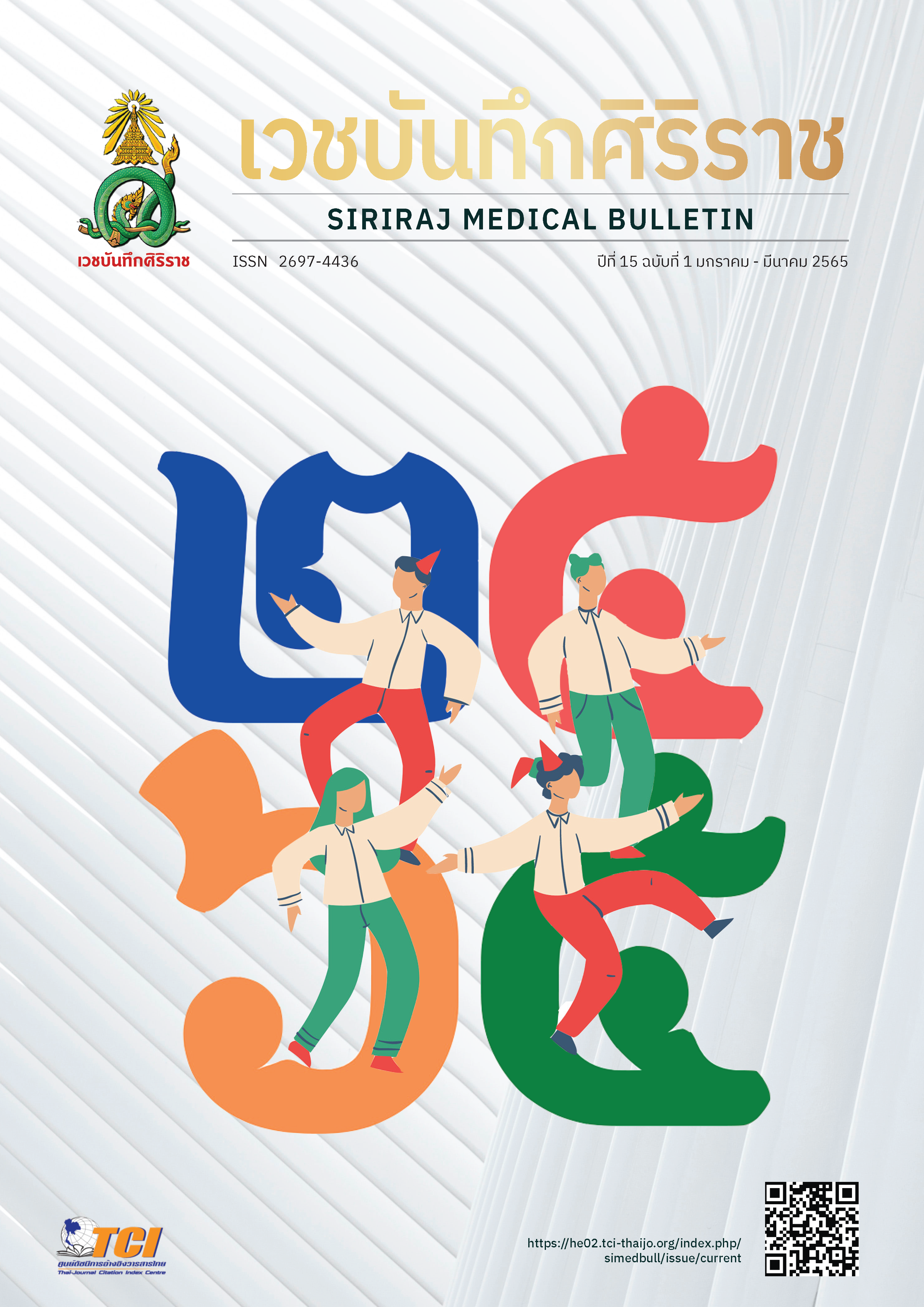Siriraj Vaccination Pathway against Tetanus-Diptheria- Pertussis in Pregnancy
Main Article Content
Abstract
Despite the fact that Tetanus-Diphtheria-Pertussis vaccine has been included in the national Extended Program of Immunization for over 40 years, the mortality rate remains remarkable, especially among children aged 0-4 years. Moreover, the incidence of pertussis, as well as its mortality, appears to be rising in recent years. As a solution, the recommendation by various academic bodies to vaccinate pregnant women with Tetanus-Diphtheria-Pertussis vaccine for each pregnancy during gestational age of 27-36 weeks has been launched. The maternal-generated immunity as an in-utero passage of antibody to the fetus which will last for the first six months of vulnerability window period has long evidently been promising. According to a systematic review, the effectiveness of preventing pertussis infection in infants was 69-91%, the prevention of infant’s admission was 91-94% and the prevention of infant deaths was 95%. Siriraj pathway for maternal immunization against Tetanus-Diphtheria-Pertussis has been proposed for the convenience of applicability to Thailand context. In the past, if a pregnant woman had not been boosted against tetanus for more than 10 years, three doses of tetanus vaccine would be needed. According to this review, only one dose booster with dT or Tdap is sufficient and the booster dose should be scheduled to give pregnant women a Tdap at recommended time when needed.
Article Details
References
2. Department of Disease Control MoPH, Thailand Annual Epidemiological Surveillance Report 2018. Available from: https://apps.doe.moph.go.th/boeeng/download/AW_Annual_Mix%206212_14_r1.pdf.
3. Roper M, Wassilak S, Tiwari T, Orenstein W. Tetanus toxoid. In: Plotkin S, Orenstein W, Offit P, editors. Vaccines. 5th ed ed. Philadelphia: PA: Saunders/Elsevier; 2012. p. 746–77.
4. Collier R. Diphtheria toxin: mode of action and structure. Bacteriol Rev 1975;39:54-85.
5. Melvin J, Scheller E, Miller J, Cotter P. Bordetella pertussis pathogenesis: current and future challenges. Nature Reviews Microbiology 2014;12(4):274-88.
6. Centers for Disease Control and Prevention. Pertussis (Whooping cough): Signs and symptoms2018. Available from: http://www.cdc.gov/pertussis/about/signs-symptoms.html.
7. de Gouw D, Diavatopoulos D, Bootsma H, Hermans P, Mooi F. Pertussis: a matter of immune modulation. FEMS Microbiology Reviews 2011;35(3):441-74.
8. สำนักงานคณะกรรมการอาหารและยา กระทรวงสาธารณสุข. Vaccine: Summary Product Characteristic. [เข้าถึงเมื่อ 15 กุมภาพันธ์ 2564]. เข้าถึงได้จาก https://www.fda.moph.go.th/sites/drug/SitePages/Vaccine_SPC-Name.aspx.
9. World Health Organization. WHO Expert Committee on Biological Standardization, sixty-second report. Geneva: World Health Organization; 2013.
10. World Health Organization. Pertussis vaccines: WHO position paper - September 2015. Wkly Epidemiol Rec 2015;90:433-58.
11. Murphy TV, Slade BA, Broder KR, Kretsinger K, Tiwari T, Joyce PM, et al. Prevention of pertussis, tetanus, and diphtheria among pregnant and postpartum women and their infants recommendations of the Advisory Committee on Immunization Practices (ACIP). MMWR Recomm Rep 2008;57:1-51.
12. Healy CM, Rench MA, Wootton SH, Castagnini LA. Evaluation of the impact of a pertussis cocooning program on infant pertussis infection. Pediatr Infect Dis J 2015;34:22-6.
13. Gall SA, Myers J, Pichichero M. Maternal immunization with tetanus-diphtheria-pertussis vaccine: effect on maternal and neonatal serum antibody levels. Am J Obstet Gynecol 2011;204:334. e1-5.
14. Amirthalingam G. Strategies to control pertussis in infants. Arch Dis Child 2013;98:552-5.
15. Centers for Disease Control and Prevention. Updated recommendations for use of tetanus toxoid, reduced diphtheria toxoid, and acellular pertussis vaccine (Tdap) in pregnant women--Advisory Committee on Immunization Practices (ACIP), 2012. MMWR Morb Mortal Wkly Rep 2013;62:131-5.
16. Baxter R, Bartlett J, Fireman B, Lewis E, Klein NP. Effectiveness of vaccination during pregnancy to prevent infant pertussis. Pediatrics 2017;139:e20164091.
17. Amirthalingam G, Andrews N, Campbell H, Ribeiro S, Kara E, Donegan K, et al. Effectiveness of maternal pertussis vaccination in England: an observational study. Lancet 2014;384:1521-8.
18. Amirthalingam G, Campbell H, Ribeiro S, Fry NK, Ramsay M, Miller E, et al. Sustained effectiveness of the maternal pertussis immunization program in England 3 years following introduction. Clin Infect Dis 2016;63:S236-43.
19. Winter K, Cherry JD, Harriman K. Effectiveness of prenatal tetanus, diphtheria, and acellular pertussis vaccination on pertussis severity in infants. Clin Infect Dis 2017;64:9-14.
20. Vygen-Bonnet S, Hellenbrand W, Garbe E, von Kries R, Bogdan C, Heininger U, et al. Safety and effectiveness of acellular pertussis vaccination during pregnancy: a systematic review. BMC Infect Dis 2020;20:136.
21. Perry J, Towers CV, Weitz B, Wolfe L. Patient reaction to Tdap vaccination in pregnancy. Vaccine 2017;35:3064-6.
22. Wanlapakorn N, Maertens K, Chaithongwongwatthana S, Srimuan D, Suratannon N, Vongpunsawad S, et al. Assessing the reactogenicity of Tdap vaccine administered during pregnancy and antibodies to Bordetella pertussis antigens in maternal and cord sera of Thai women. Vaccine 2018;36:1453-9.
23. Lindley MC, Kahn KE, Bardenheier BH, D'Angelo DV, Dawood FS, Fink RV, et al. Vital signs: Burden and prevention of influenza and pertussis among pregnant women and infants - United States. MMWR Morb Mortal Wkly Rep 2019;68:885-92.
24. McAuslane H, Utsi L, Wensley A, Coole L. Inequalities in maternal pertussis vaccination uptake: a cross-sectional survey of maternity units. J Public Health 2018;40:121-8.
25. Mohammed H, Clarke M, Koehler A, Watson M, Marshall H. Factors associated with uptake of influenza and pertussis vaccines among pregnant women in South Australia. PLoS One 2018;13:e0197867.
26. Committee Opinion No. 718: Update on Immunization and Pregnancy: Tetanus, Diphtheria, and Pertussis Vaccination. Obstet Gynecol 2017;130(3):e153-e157.
27. Maternal immunization against tetanus. Integrated management of pregnancy and childbirth (IMPAC). Geneva World Health Organization, 2006. Available from: https://www.who.int/reproductivehealth/publications/
maternal_perinatal_health/immunization_tetanus.pdf, accessed 6 March 2021.
28. Liang JL, Tiwari T, Moro P, Messonnier NE, Reingold A, Sawyer M, Clark TA. Prevention of Pertussis, Tetanus, and Diphtheria with Vaccines in the United States: Recommendations of the Advisory Committee on Immunization Practices (ACIP). MMWR Recomm Rep 2018;67:1-44.
29. Centers for Disease Control and Prevention. Administering Diphtheria, Tetanus, and Pertussis Vaccines 2020. Available from:https://www.cdc.gov/vaccines/vpd/dtap-tdap-td/hcp/administering-vaccine.html.






